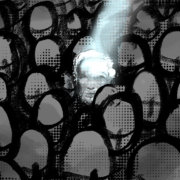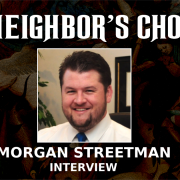The Prisoner
“The degree of civilization in a society can be judged by entering its prisons.”
~Fyodor Dostoevsky
Before the Gospel revelation, justice consisted of directing the guilt of the entire society against a single victim. It was widely experienced, just as it is today, that shifting the blame onto another is an effective way of postponing an imminent violent outbreak that often results from mimetic desire. The ancient societies carried out this phenomenon under the ritual of human sacrifice. And as recent as the twentieth century, we see this phenomenon repeated in ideological and secular dressing with the atrocities committed in Nazi Germany and the Soviet Union.
But what we often overlook, due to clueless academic reading of ancient texts, are other forms of sacrifice—sacrifice not involving outright murder but instead refined to expulsion or confinement. Imprisonment is the most accurate word for this type of sacrifice. While a case can be made that imprisonment in and of itself does not comprise human sacrifice, it does not negate the current widespread injustice that can be traced back to the sacrificial origins of the practice.
In Greek mythology, we find that imprisonment was sacralized (and even deified) as Tartarus. It is widely accepted that in ancient mythology the concept of creation ex nihilo is nowhere to be found. What should also be known is that the creation stories in mythologies were filled with sacrificial beginnings. Tartarus is one of the outcomes of such a violent beginning. Once the abyss reserved for the dehumanized fallen enemies of the victorious gods, Tartarus later became the prison for sinful mortals, many of whom were kings and warriors.
The transition from the abyss for gods and titans to eternal prison for rebellious mortals is not surprising if one takes into account the role of religion in shaping culture and institutions. For any institution to carry out its task in an efficient manner, a transcendental founding is necessary. It is for this reason that the ancient civilizations of Egypt, Rome, and Babylon had prisons while Israel had none. The prison-filled civilizations all had one thing in common: a founding myth concealing a murder.
Contrast the pagan view of the prisoner with the Biblical accounts. In mythology, the confinement or expulsion of the single victim is a necessity for the temporary prevention of violent conflict. Therefore, prisons became a necessity, and the prisoner, post sacrifice, was deified as a sacred victim—a god through whom society derived their momentary peace. On the other hand, texts like that of Joseph in the Old Testament proclaimed the victim as innocent and the recipient of an unjust prison sentence.
Fast forward to the Gospels and here, in the passion narrative, we have a direct response to pagan mythology. The God-man Christ Jesus, after being sentenced to die by the Sanhedrin, is first imprisoned and then crucified—confined and sacrificed. It is absolutely intentional, to put it in a literary way, that Christ is both divine and human, for Tartarus was the abyss of both gods and men. The crucifixion of Christ is the careful dissecting and utter deconstruction of the pagan Tartarus myth. The anthropological impact of this story is beyond compare.
With Christ’s crucifixion, a reverse-mythology is set in place, and its effects have reached into the deepest subconsciousness of the human psyche. No longer do we consider the prisoner as an essential human sacrifice for the good of the many, for the prisoner has been proclaimed innocent. In light of this revelation, the modern-day mythmaking for mass incarceration is shaken to its very foundation. The prisoner has been humanized and the structures laid bare.
With Christ’s crucifixion, not only do we see the innocence of the victim but we also see true justice as God’s reign on Earth. During His trial, Jesus, the personification of innocence, was condemned to death while freedom was granted by the crowd and ruler to the violent revolutionary Barabbas. Here, we see the contrast between true justice and sacrificial justice. Violent institutions give rise to violent revolutions. It is not surprising that our modern-day prison-industrial complex unleashes countless Barabbases into the population; crime is multiplied. As a result, the cycle of violence is spinning on and on.
Justice, as revealed at Calvary, is the rehabilitation of our neighbors. Whereas the world locks up non-violent, vice-ridden individuals in the violent abyss of Tartarus and throws away the key, godly justice is the healing of the sick, the rehabilitation of the addicted, and the exorcism of the possessed. This is not naivety; this is the commandment of our Lord. The apostle Paul said, “Do not be overcome by evil, but overcome evil with good.” This is the proven method of introducing peace in the realms of governance and legislation as observed in Christianity’s gradual effect on society, particularly in terms of individual and property rights.
As Christ-haunted nations, it is very clear: we cannot put non-violent law offenders in prisons where violence is rampant. While it is logical and sensible to detain violent criminals for the good of our loved ones, it is equally diabolical to throw non-violent drug offenders, unlicensed farmers, whistleblowers, and others into cages filled with wild violence. The Christ-captivated conscience of our society does not allow for such barbarism, even if it is written into law. Why then do we allow such lawlessness to be perpetuated by the government?
Perhaps it is time to direct our Christ-haunted society once again to the Lord’s prayer wherein Jesus says: Your kingdom come, your will be done on earth as it is in heaven. To be ruled by Prince of peace is to set the captives free, and we cannot ignore the countless captives languishing in prison. No matter how safe we feel, our conscience will not allow it.












Leave a Reply
Want to join the discussion?Feel free to contribute!